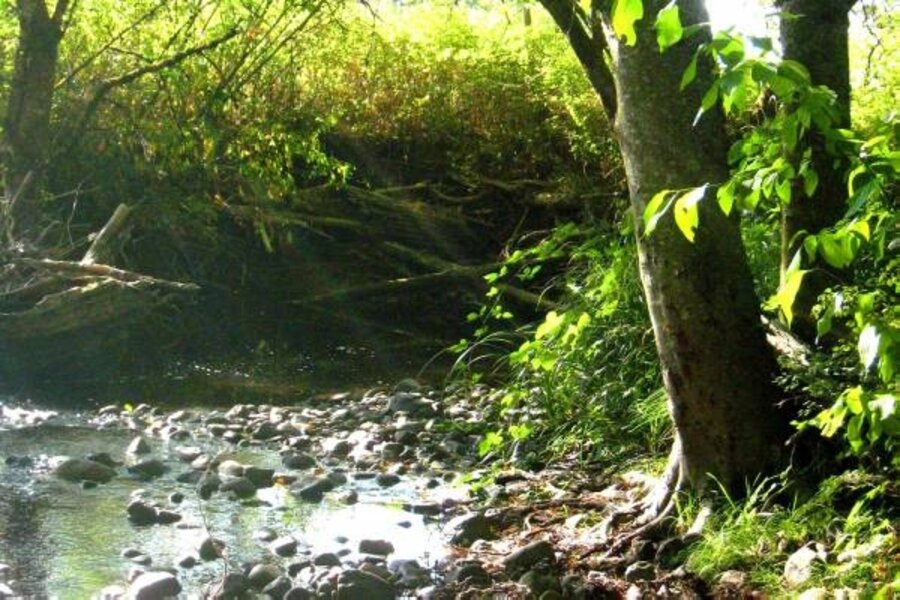How to place rocks around water gardens
Loading...
We’ve all seen them, those water features — particularly small ponds — dotted on the edges with natural rocks that look totally artificial. You may even own one.
After years of writing about backyard water features all over the country, I’ve come to think of this artificiality as distinguished by “same-size syndrome.” All the rocks around the pool are either, as the contractors say, “one-” or “two-person” rocks. That’s the number of people it takes to position them.
Sometimes this effect results because you don’t have the money to pay for the equipment that could place really big boulders. But I have also seen same-size syndrome on massive features that took up most of a water gardener’s budget.
If you’re happy with that look, read no more. But if you’d like to improve upon what you have, or if you’re planning a new water feature — and winter’s the best time for making those plans — read on.
Back to nature
The best place to study nature is in it. Your goal is not to duplicate what you see. Instead you’re looking for specific elements that come into play. So make a trek to nearby streams, ponds or waterfalls.
A nice day in winter is not a bad time to plan such a hike if the water is accessible. Without the surrounding greenery, the bones of the watercourse are more apparent. Don’t forget to bring your camera.
Of course, the first thing you’ll notice is that water in nature has no same-sizeness. In fact, it’s downright messy. Study the variety of pebbles, stones, rocks, and boulders that make up any rocky water element.
On the other hand, some streams, and many ponds, have no rocks but feature plants that plunge right down to the water — grasses on the shoreline change to cattails in the water without a perceptible line of demarcation.
Water tells a story as it moves or gathers. On curves, it scours out one side and builds up the other. Small pools form around the base of waterfalls. On flatter ground, water wends its way in serpentines. A straight stream on the flat will resemble a ditch — definitely more man-made.
If you can, return to the same observation spot as the seasons change. A rise or lowering of water level will also give you information you can use at home.
Supplement your own photos with a collection of ones you like in magazines and on the Web.
Bring it all back home
To add variety to water you already have or when planning a new feature, specify all sizes of rocks.
There are thousands of hard rock types — no shales need apply — depending on where you live in the US, but choose those closest to home. Not only will you save money — shipping rock is expensive — but your water feature will look more like it belongs in your part of the world.
Add other sizes of stones to your existing water feature. Remove some of the smaller DIY rocks and spend money on one or two bigger boulders. Have them professionally placed. That’s still much cheaper than if you paid for a whole professional construction job, and will give you that more naturalistic look.
Also, you can add many smaller stones, right down to pebbles, around the rocks you already have to break up the rhythm of the same-size syndrome.
Don’t be afraid to bury a good deal of the rock, especially the larger ones. Nature rarely leaves rocks teetering on top of the soil — she moves them along until they lodge or get covered with debris.
Or, she exposes just the surface of a deeply buried rock. While it’s hard to pay good money for something that’s going to be covered up, it’s the key to making the rocks look right.
You can also break up the same-size syndrome with planting pockets. Remove the rocks in a section of the pond edging and create a bog garden there instead. Underlay the area with the pond liner and put in plants that thrive with wet feet. (I’ll talk about how to naturalize water features with plant material in other posts.)
Do you have photos of your favorite water places in nature? Let me know what lessons you’ve brought home to your own back yard from your forays into the natural world.
Mary-Kate Mackey, co-author of “Sunset’s Secret Gardens — 153 Design Tips from the Pros” and contributor to the “Sunset Western Garden Book,” writes a monthly column for the Hartley Greenhouse webpage and numerous articles for Fine Gardening, Sunset, and other magazines. She teaches at the University of Oregon’s School of Journalism & Communication. She writes about water in the garden for Diggin’ It.
Editor’s note: To read more by Mary-Kate, check our blog archive. Gardening articles on a variety of topics can be found at the Monitor’s main gardening page. Also see our RSS feed. You may want to visit Gardening With the Monitor on Flickr. Take part in the discussions and get answers to your gardening questions. If you join the group (it’s free), you can upload your garden photos and enter our next contest.


